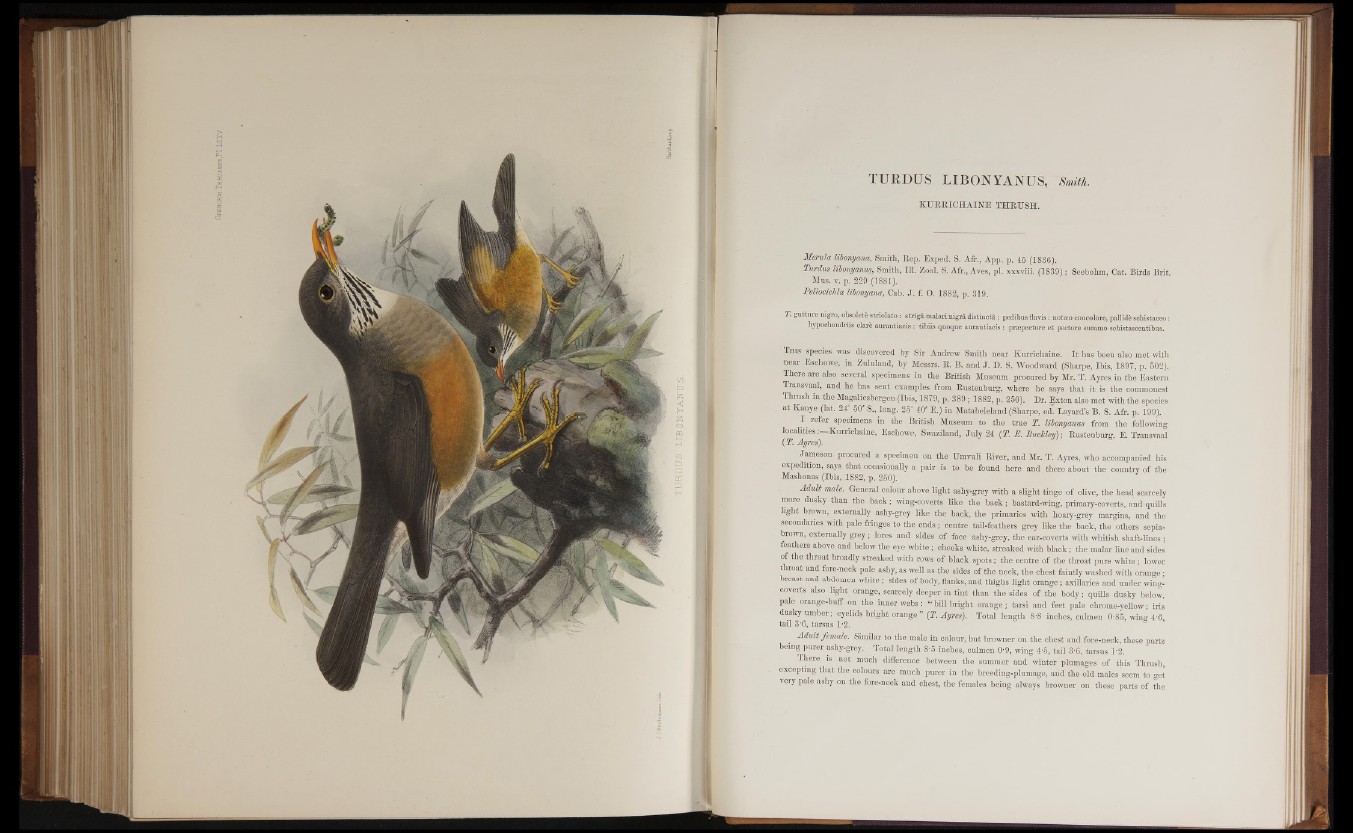
TURDUS L IBO N Y A N U S .
TURDUS LIBONYANUS, Smith.
KURRICHAINE t h r u s h .
Merula libonyana, Smith, Rep. Exped. S. Afr., App. p. 45 (1836).
Turdus libonyanus, Smith, 111. Zool. S. Afr., Aves, pi. xxxviii. (1839); Seebohm, Cat. Birds Brit.
Mus. v. p. 229 (1881).
PeUoeiehla libonyana, Cab. J. f. O. 1882, p. 319.
T. gutture nigro, obsolete striolato: strigS. malari nigril distinctii: pedibus flavis: rot!£o concolore, pallide schistaceo:
hypochondrias clare aurantiaeis: tibiis quoque aurantiaeis : prsepectore et pectore summo schist ascentibus.
This species- was discovered by Sir Andrew Smith near Kurrichaine. It has been also met with
near Eschowe, in Znluland, by Messrs. R. B. and J. D. S. Woodward (Sharpe, Ibis, 1897, p. 502).
There are also several specimens in the British Museum procured by Mr. T. Ayres in the Eastern
Transvaal, and he has sent examples from Rustenburg, where he says that it is the commonest
Thrush in the Magaliesbergen (Ibis, 1879, p. 389 ; 1882, p. 250). Dr. Exton also met with the species
at Kanye (lat. 24° 50' S., long. 25° 40' E.) in Matabeleland (Sharpe, ed". Bayard’s B. S. Afr. p. 199).
I refer specimens in the British Museum to the true T. libonyanus from the following
localities:—Kurrichaine, Eschowe, Swaziland, July 24 (21 E. Buckley); Rustenburg, E. Transvaal
(21 Ayres).- . ' 6
Jameson procured a specimen on the Umvuli River, and Mr. T. Ayres, who accompanied his
expedition, says that occasionally a pair is to be found here and there about the country of the
Mashonas (Ibis, 1882, p. 250).
Adult male. General colour above light ashy-grey with a slight tinge of olive, the head scarcely
more dusky than the hack; wing-coverts like the back; bastard-wing, primary-coverts, and quills
light brown, externally ashy-grey like the back, the primaries with hoary-grey margins, and the
secondaries with pale fringes to the ends ; centre, tail-feathers grey like the back, the others sepia-
brown, externally grey; lores and sides of face ashy-grey, the ear-coverts with whitish shaft-lines ;
feathers above and below the eye white; cheeks white, streaked with black; the malar line and sides
of the throat broadly streaked with rows of black spots; the centre of the throat pure white ; lower
throat and fore-neck pale ashy, as well as the sides of the neck, the chest faintly washed with orange;
breast and abdomen white ; sides of body, flanks, and thighs light orange; axillaries and under wing-
coverts also light orange, scarcely deeper in tint than the sides of the body; quills dusky below,
pale orange-buff on the inner webs: “ bill bright orange; tarsi and feet pale chrome-yellow; iris
dusky umber; eyelids bright orange ” (21 Ayres). Total length 8-8 inches, culmen 0-85, wing 4-6
tail 3-6, tarsus 1-2.
Adult female. Similar to the male in colour, but browner on the chest and fore-neck, these parts
being purer ashy-grey. Total length S-5 inches, culmen 0-9, wing 4-5, tail 3'6, tarsus 1-2.
There is not much difference between the summer and winter plumages of this Thrush,
excepting that the colours are much purer in the breeding-plumage, and the old males seem to get
veiy pale ashy on the fore-neck and chest, the females being always browner on these parts of the